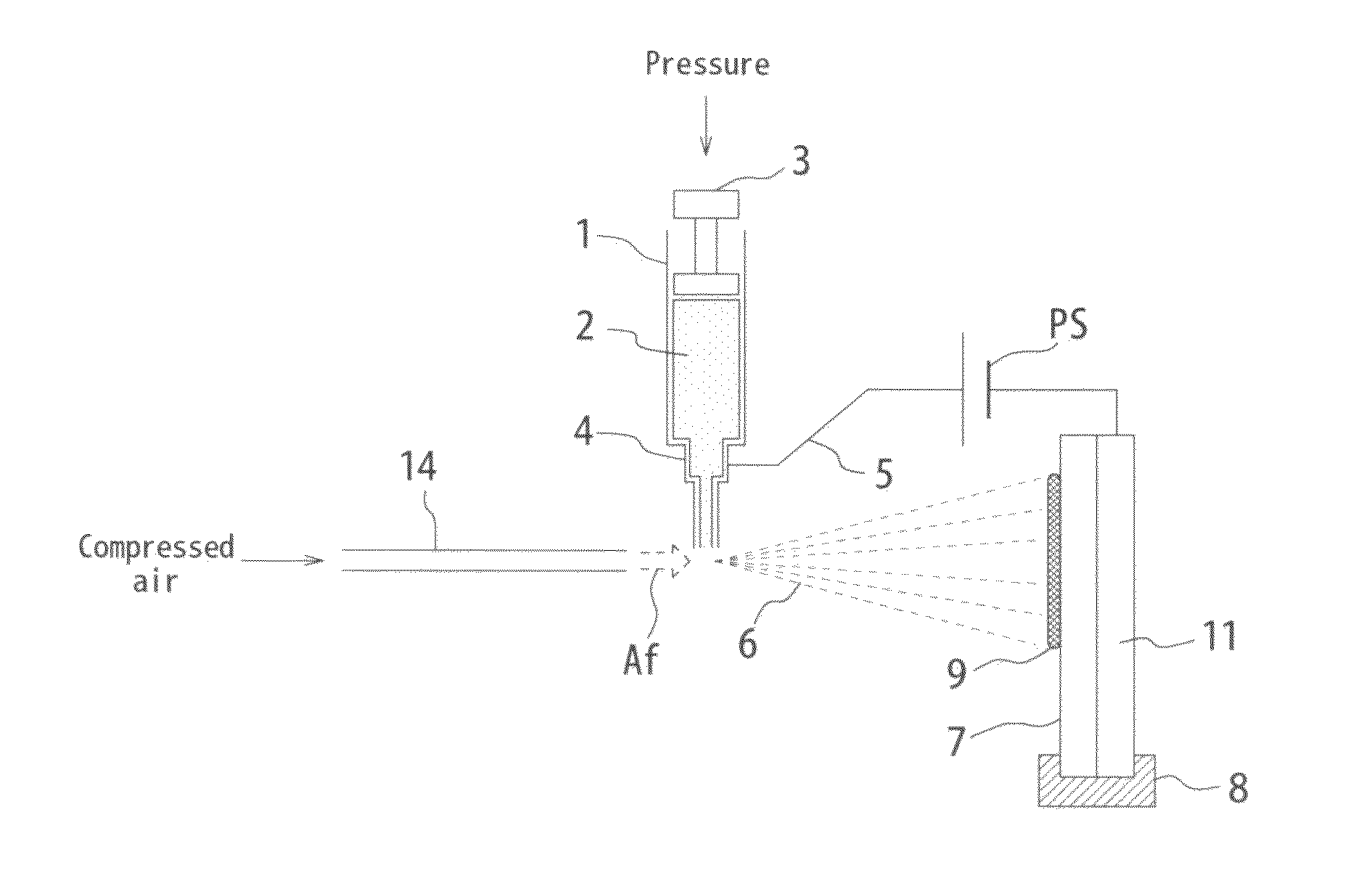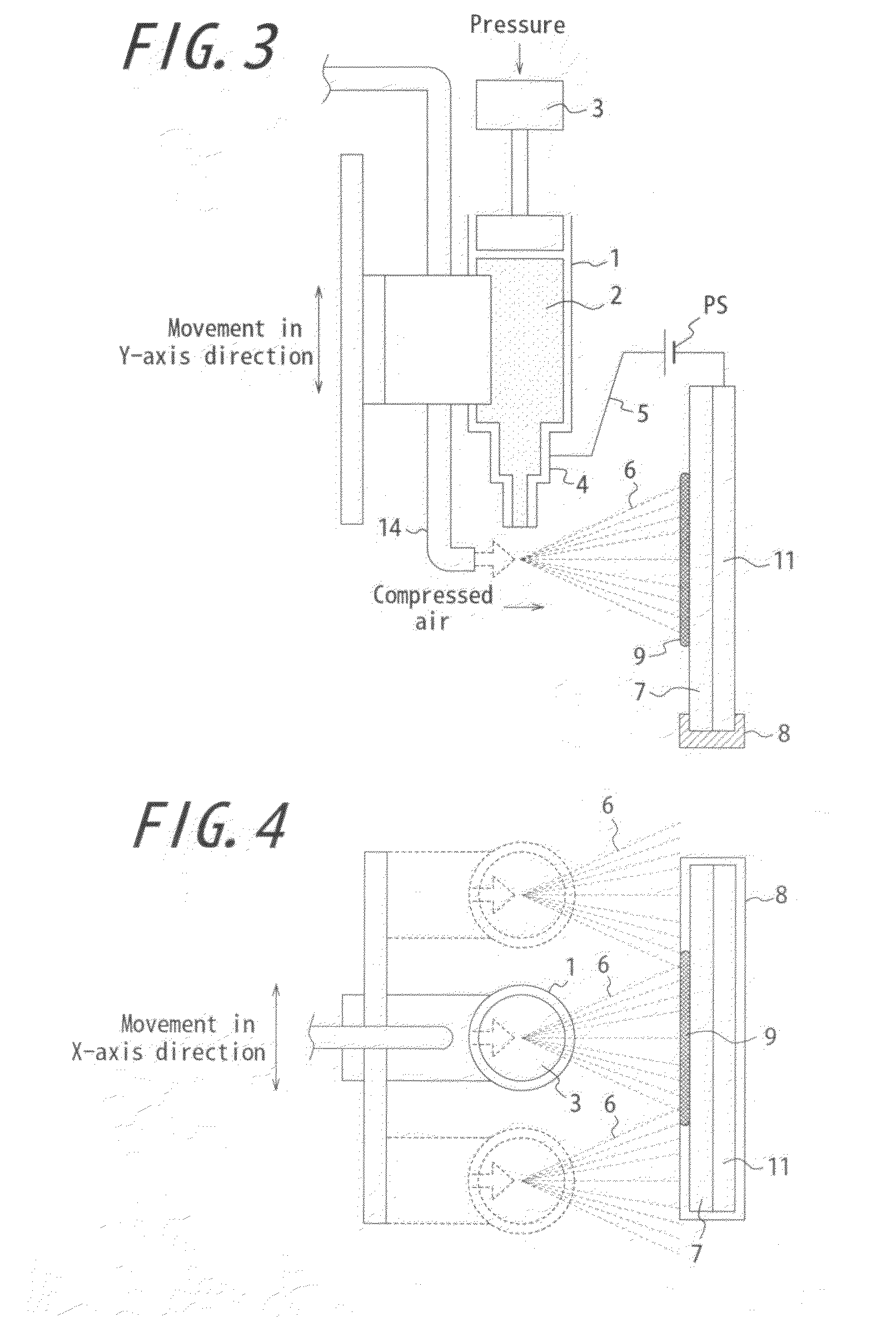Immobilization apparatus
a technology of immobilization apparatus and nozzle, which is applied in the direction of electrostatic spraying apparatus, electrostatic heating/cooling, coating, etc., can solve the problems of inability to form thin films, and inability to form small amounts of films, so as to facilitate the generation of microparticles and reduce particle size.
- Summary
- Abstract
- Description
- Claims
- Application Information
AI Technical Summary
Benefits of technology
Problems solved by technology
Method used
Image
Examples
embodiment 1
[0080]FIG. 1 is a conceptual view showing a basic configuration of an immobilization apparatus according to one embodiment of the invention. As shown, a syringe (container) 1 stores a sample solution 2. The sample solution 2 is, for example a biopolymer solution such as a protein, an organic polymer solution, a polymer solution or the like.
[0081]Also, the sample solution within the syringe 1 receives extrusion pressure at a plunger (exhausting means) 3. The extrusion pressure is applied by a stepping motor and a feed screw mechanism (not shown). The extrusion pressured sample solution 2 increases the inner pressure within the syringe 1, and is exhausted from the tip of a nozzle 4. As mentioned above, by providing a regulating mechanism (stepping motor and feed screw mechanism) for regulating the exhaust rate of a sample solution, it becomes possible to regulate the exhaust rate as appropriate. By such a regulation, it becomes possible to obtain a dry deposit instead of a wet deposit...
embodiment 2
[0088]FIG. 2 is a conceptual view showing a basic configuration of an immobilization apparatus according to another embodiment of the invention. Hereinafter, in each figure, the same elements are labeled with the same reference mark and the explanation thereof is omitted. The apparatus in FIG. 2 is different from the one in FIG. 1 in the point that while the direction of the high velocity airflow Af spouts from immediately lateral to a nozzle in FIG. 1, it is configured to spout from obliquely upside in FIG. 2. Atomization is likewise possible from obliquely upside or immediately above as the direction of the airflow Af. In FIG. 2, the airflow Af is crashed into the sample solution 2 positioned in an exhaust outlet EXT from obliquely upside avoiding the syringe 1 to deposit the sample on the level substrate 7. By such an arrangement, it is possible to hit the tip portion of the nozzle 4 with the airflow Af avoiding the syringe 1 so as not to lose the momentum of the airflow Af for e...
embodiment 3
[0089]FIGS. 3 and 4 are conceptual views each showing a basic configuration of an immobilization apparatus according to another embodiment of the invention. The apparatus shown in FIGS. 3 and 4 are different from the apparatus shown in FIG. 1 mainly in that the syringe 1 and the tube 14 are configured to be driven on a planar surface parallel to the planar surface of the substrate 7. FIG. 3 explains a configuration in which the syringe 1 and the tube 14 are drive in the Y-axis direction (vertical direction) and FIG. 4 explains a configuration in which the syringe 1 and the tube 14 are drive in the X-axis direction (horizontal direction). As seen from the figures, in this embodiment, the syringe 1 and the tube 14 are provided so that they can be independently driven by a driving means in the Y-axis direction and a driving means in the X-axis direction. The syringe 1 and the tube 14 change a position where the particulate substance 6 is deposited by changing the relative positional re...
PUM
 Login to View More
Login to View More Abstract
Description
Claims
Application Information
 Login to View More
Login to View More - R&D
- Intellectual Property
- Life Sciences
- Materials
- Tech Scout
- Unparalleled Data Quality
- Higher Quality Content
- 60% Fewer Hallucinations
Browse by: Latest US Patents, China's latest patents, Technical Efficacy Thesaurus, Application Domain, Technology Topic, Popular Technical Reports.
© 2025 PatSnap. All rights reserved.Legal|Privacy policy|Modern Slavery Act Transparency Statement|Sitemap|About US| Contact US: help@patsnap.com



